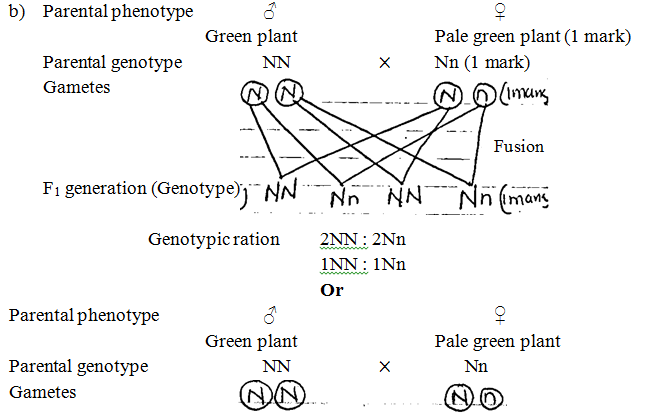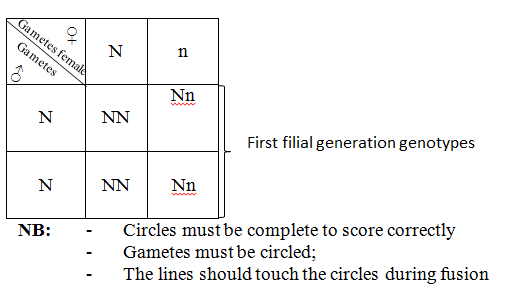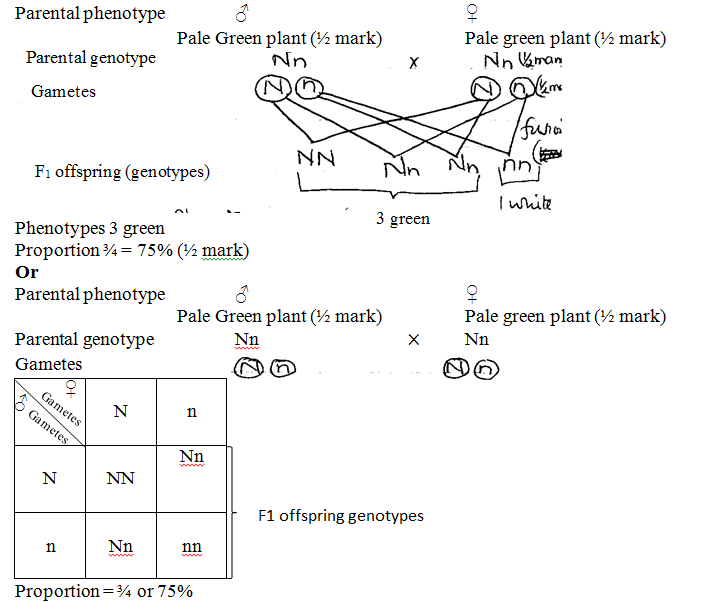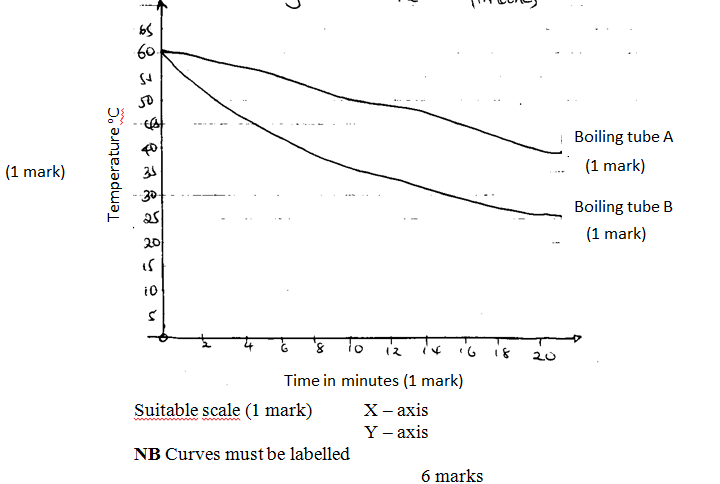Marking Scheme
SECTION A
-
- Photosynthesis;
-
- Presence of light intensity;
- Presence of chlorophyll;
- Availability of water;
- Carbon (IV) oxide concentration;
- Temperature; Mark first two points
- Oxygen
- Used in respiration or oxidation of substances to yield energy;
- Some oxygen is released into the atmosphere;
- used in respiration;
- Some is converted to starch or sucrose for storage;
- Is used in the formation of structures in plants e.g cellulose cell wall/cytoplasm;
- Used for growth and development;
- Formation of various structures 7 marks maximum 5
-
- Root (1 mark)
-
- Presence of endodermis;
- Presence of hairs;
- Xylem is star-shaped at the centre while phloem is in between the arms of the xylem; Mark first two points
- J – Epidermis; K – Phloem; L – Xylem; (3 marks)
-
- Absorption of water;
- Absorption of mineral salts; (2 marks)
-
- Lack of organic food; because plants are white hence they lack chlorophyll; the plant cannot photosynthesize hence no starch is formed; the plant dies as soon as the food reserves are depleted; (2 marks)
-
-
-
- Biological control is using a living organism to regulate or control or reduce the population of another organism; (1 mark)
-
- Eutrophication is the enrichment of water bodies with minerals or nutrients like nitrates/phosphates/sulphates; due to discharge of sewage/domestic effluent water; containing water detergents/run off water fertilizers leading to rapid growth of aquatic plants /phytoplankton’s; (3 marks)
- Effect of eutrophication;
- Excessive growth of aquatic plants / proliferation of aquatic plants blocks light from reacing the plants underneath and thus plants will not photosynthesize;
- Plants die and decompose leading to the depletion of dissolved oxygen;
- Animals also die or suffocate; (3 marks
- Nitrogen (IV) oxide or sulphur (IV) oxide (1 mark)
-
-
- Is a condition where male part / stamens mature and shed pollen grains before female part/stigma/pistil of the same flower is ready to receive them; (1 mark)
- Self-sterility – is a condition where pollen grains from anthers cannot grow on the stigma incompatible to the stigma of the plant / flower; (1 mark)
-
- Q-Antipodal cell;
R – Polar nucleus / polar body;
S – Egg cell / functional egg; (3 marks) -
- Offer path through which the male gametes reach the embryo sac to enhance fertilization;
- Prevent other pollen grains from developing into pollen tube hence no multiple fertilization of embryo sac;
- Secrete enzymes that digest the stigma or ovary tissue; Mark first two points
- Q-Antipodal cell;
-
SECTION B
-
- A graph showing heat loss on tubes A and B against time (1 mark)
-
-
(4 marks)
- Test tube B has a larger surface area making it to loose heat to the surrounding faster than boiling tube A which has a smaller surface area hence loses heat slowly; (2 marks)
- A rat has a larger surface area to volume ratio compared to an elephant; hence the rat loses heat at a faster rate than an elephant; or an elephant has a smaller surface area to volume ratio compared to a rat; hence loses heat slowly than a rat; (2 marks)
-
-
- Insulate against heat loss to the surrounding; (1 mark)
-
- Subcutaneous fat (layer) or adipose tissue;
- Fur/hair (2 marks)
-
- Are active always; even under cold conditions;
- Can survive in any habitat / wide range of habitats (both cold and hot);
- Able to escape from predators, or able to search for food / mates under all conditions; (3 marks)
- A graph showing heat loss on tubes A and B against time (1 mark)
-
- Comparative embryology is comparing formation and development of embryos; this study shows that vertebrate embryos have similar morphological features during their early development and it is impossible to tell them apart; this indicates a common ancestry; some features include single circulatory system, segmented myotomes gill slits / visceral clefts, notochord and tail. Mark any two points
- Structure and functions of various parts of the human ear. (18 marks)
The ear is an organ involved in perceiving sound and maintaining body balance and posture. It has the following structures to carry out various functions;- Pinna – Its funnel shaped to collect and direct sound waves into the external auditory meatus;
- External auditory meatus – concentrates or directs sound waves to the tympanic membrane which vibrates; has hairs that prevents entry of dust particles or any foreign materials to avoid obstruction of sound waves; has wax secreting cells that secrete wax to trap insects, dust or foreign materials that can damage the eardrum;
- Tympanic membrane – Is a thin membrane which vibrate according to sound waves that hit it; converting sound waves into vibrations; sound waves are then transmitted to ear ossicles;
- Ear ossicles – are three small bones namely malleus, anvil and incus; they are joined firmly to one another by ligaments / muscles to transmit vibrations across the middle ear; they form a system of lever which amplify and transmit sound vibrations to the oral window; they are suspended in the air by muscles to vibrate more freely; and prevent excessive vibrations;
- Oral window / Fenestras ovalis – Thin membrane to vibrate effectively; and smaller in size than tympanic membrane; it amplifies vibrations; and transmits them to the fluids in the cochlea;
- Cochlea – Has fluids perilymph and endolymph; that distort / displace sensory hairs thereby generating a nerve impulse; is coiled to offer a large surface for many sensory cells for hearing; has the organ of corti that has auditory cells that generate nerve to convey impulses to the brain for interpretation i.e hearing;
- Eustachian tube – Opens at the Pharynx to communicate to the mouth cavity; to equalize air pressure in the middle ear with the atmospheric air pressure;
- Round window / Fenestra rotunda – Is a thin membrane that stops disturbance / displacement / distortation of cochlea fluid; by pushing towards the middle ear for vibrations to die / diffuse off;
- Vestibular apparatus – Consists of three semi-circular canals with ampula that detects the direction of movement of the head; has succulus and utriculus with an otolith that detects the position of the head with respect to gravity; endolymps flows to displace the sensory hairs that detect body balance; and vestibular nerve that transmits impulse to the brain for interpretation; i.e position or balance of the body; 25 marks maximum 18 marks
-
- Mechanism of gaseous exchange in a mammal
Gaseous exchange occurs in two stages:- Inhalation (Breathing in)
- External intercostal muscles contract; while internal intercostal muscles relax; this causes raising of the ribcage upwards and outwards; muscles of the diaphragm contract hence diaphragm flattens; The volume of the thoracic cavity increases; and pressure decreases than the atmospheric pressure; the higher air pressure in the atmosphere forces air into the lungs; and lungs inflate;
- Exhalation (Breathing out)
- External intercostal muscles relax; while internal intercostal muscles contract; this causes the ribcage to move downwards and inwards; the muscles of the diaphragm relax; and the diaphragm assumes a dome – shape; this makes the volume of the thoracic cavity to decrease; while pressure increases compared to the atmospheric pressure; higher pressure in the thoracic cavity forces air out of the lungs; and the lungs deflate (16 marks)
- Inhalation (Breathing in)
- Mechanism of stomatal opening:
During the day photosynthesis takes place in the guard cells; forming sugar / glucose; glucose is osmotically active hence guard cells draw water by osmosis from adjacent epidermal cells; guard cells become turgid and bulge outwards; thin outer wall expands faster hence thick inner wall curves; causing the stomatal aperture to open; 5 marks maximum 4
- Mechanism of gaseous exchange in a mammal
Join our whatsapp group for latest updates
Tap Here to Download for 50/-
Get on WhatsApp for 50/-
Download BIOLOGY PAPER 2 Marking Scheme - 2017 KITUI MOCK EXAMINATION.
Tap Here to Download for 50/-
Get on WhatsApp for 50/-
Why download?
- ✔ To read offline at any time.
- ✔ To Print at your convenience
- ✔ Share Easily with Friends / Students



